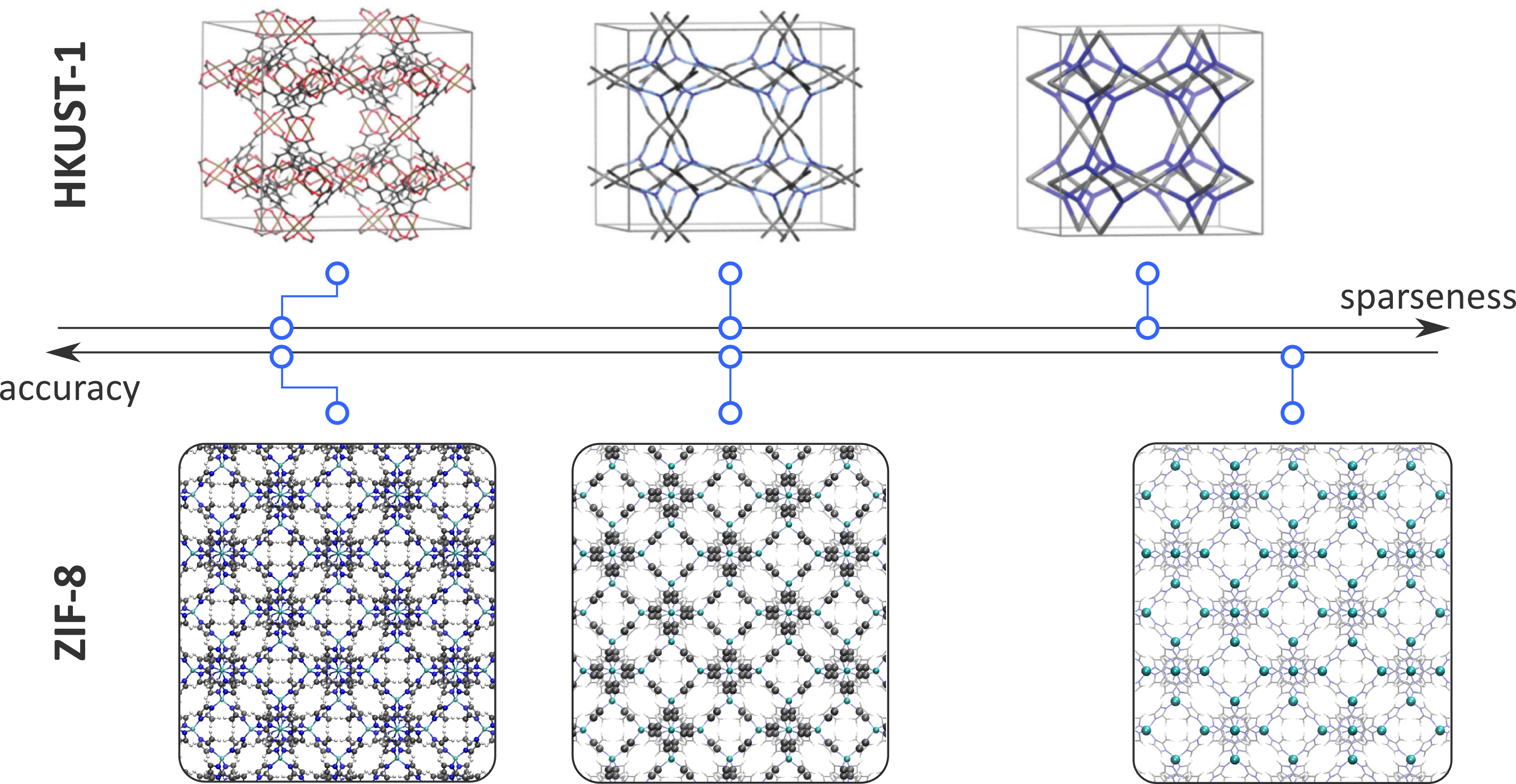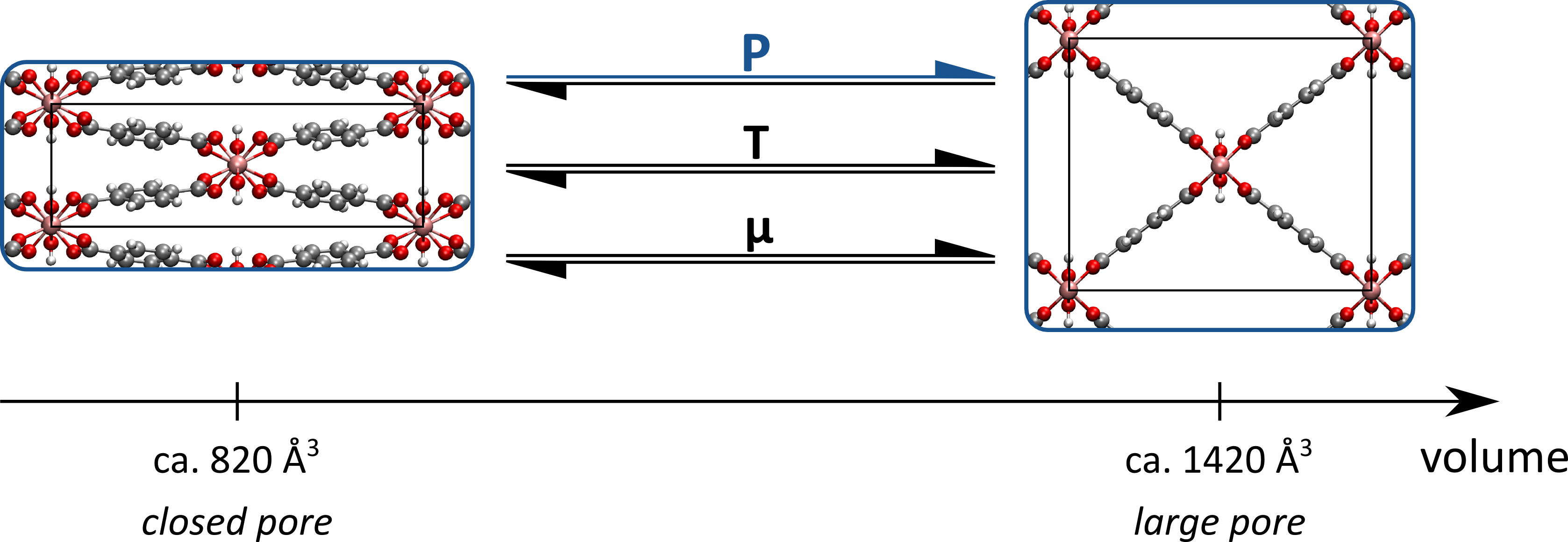Exploring the feasibility of coarse-graining to describe the attractive thermal and mechanical phenomena of flexible and defected metal-organic frameworks
Exploring the feasibility of coarse-graining to describe the attractive thermal and mechanical phenomena of flexible and defected metal-organic frameworks
Promotor(en): V. Van Speybroeck, T. Verstraelen /18NANO10 / Nanoporous materialsThanks to recent advances in computational techniques and the growing access to high-performance computing facilities, computationally-aided design of materials has entered a promising era with seemingly unlimited possibilities. The Center for Molecular Modeling (CMM), which is at the forefront of these advances, especially focuses on nanoporous materials such as metal-organic frameworks (MOFs). MOFs, composed of inorganic metal-oxide clusters interconnected by organic ligands, are omnipresent in a large range of applications, from energy storage and conversion, over sustainable chemistry, to biomedical applications. Moreover, the hybrid nature of MOFs makes them ideally suited to systematically engineer their building blocks, for instance by exchanging metals of the inorganic clusters, adding chemical functionalities to the organic ligands, or intentionally creating missing ligands in these materials. While synthesizing this huge variety of possible materials is a very time-consuming endeavor, the problem can be tackled efficiently by computationally predicting the best performing combinations of building blocks in a reliable and accurate way, guiding experimentalists towards a smaller set of materials to be synthesized.
To predict the best performing combinations of building blocks, thermodynamic quantities of MOFs are determined from simulations on the molecular scale. The most important feature of such simulations is the description of the potential energy surface. In essence, we need to deal with quantum mechanics to determine the potential energy for each molecular configuration. In order to study larger systems and longer time scales, the quantum mechanical energy surface can be approximated with force fields. When using force fields, the internuclear interactions are modelled using predefined, analytical functions which can be evaluated much faster, such that materials on the order of a thousand of atoms can be simulated for several nanoseconds. However, to comprehensively study the large-scale effects which influence the aforementioned systematic engineering of materials and reliably answer questions such as “Why do missing ligands preferentially cluster into domains of several nanometers?” and “Given two types of functionalized linkers, how will they preferentially be distributed throughout the material?”, even larger systems are necessary. To this end, reliable techniques to reduce the number of force field terms, so-called coarse-graining techniques, need to be developed and benchmarked. As indicated in Figure 1 for two prototypical MOFs, HKUST-1 and ZIF-8, coarse-graining techniques need to find a balance between accuracy and sparseness of the representation. An approach based on the variational minimization of the ‘difference’ between the free energies of the original and the sparse representation was recently introduced by two groups, leading to the ‘best’ representation given a threshold on the number of force field terms [1, 2]. However, it is yet unclear how they perform to describe the challenging class of MOFs.

Goal
Recently, we implemented at the CMM a coarse-graining method based on this variational minimization of the Kullback-Leibler divergence, an alternative and widely-used technique, which has however not yet been systematically adopted for MOFs. In this thesis, it is the intention to thoroughly benchmark the performance of this newly developed technique for the accurate description of the thermal and mechanical phenomena of MOFs. Given the surprising flexibility in these porous solids, they form the ideal case study to test the applicability and limits of coarse-graining, and investigate the trade-off between accuracy and sparseness.
The thesis will focus on two materials. At first instance, we will focus on the rigid HKUST-1 (see also the top row in Figure 1), as an alternative coarse-grained model for this material that can be adopted for benchmarking purposes was recently developed by prof. Rochus Schmid, with whom we collaborate [3]. Besides investigating the perfect material, we will also explore the effect of intrinsic mesopores in the material on its thermal and mechanical properties. Given the spatial extent of these mesopores, an accurate coarse-grained model for this material is essential to obtain reliable information on their influence on the macroscopic properties of the material [4]. Second, our study will focus on MIL-53(Al), a MOF which exhibits two (meta)stable phases, as indicated in Figure 2. MIL-53(Al) is one of the prototypical flexible MOFs, for which transitions between the two (meta)stable states can be triggered by external stimuli such as temperature, pressure, and guest adsorption. In this thesis, we will investigate to which extent this material can be coarse-grained while still describing well the critical pressure necessary to induce a phase transition, given our ample experience on this material. A coarse-grained model that accurately captures this transition pressure would be an enormous step forward to shed light on the phenomenon of phase transitions in this material, allowing us to study to which extent this transition has to occur in a collective fashion, or can rather lead to the stable co-existence of both (meta)stable states in a given material.

The student will be actively coached to make him/her acquainted with the several advanced simulation and coarse-graining techniques early in the thesis year, and to transfer necessary programming skills needed to perform the research.
Aspects
Physics aspect: Derivation of a coarse grained model, starting from interactions on a molecular level.
Engineering aspect: Exploration of the effect of mesopores and flexibility on the macroscopic properties of the materials..
- Study programmeMaster of Science in Engineering Physics [EMPHYS], Master of Science in Physics and Astronomy [CMFYST]ClustersFor Engineering Physics students, this thesis is closely related to the cluster(s) NANO, MODELINGKeywordsCoarse graining, Force fields, Molecular simulation, Nanoporous materials, FlexibilityReferences
[1] I. Bilionis and P. S. Koutsourelakis, "Free energy computations by minimization of Kullback-Leibler divergence: An efficient adaptive biasing potential method for sparse representations," J. Comput. Phys., vol. 231, no. 9, pp. 3849-3870, 2012.
[2] O. Valsson and M. Parrinello, "Variational approach to enhanced sampling and free energy calculations," Phys. Rev. Lett., vol. 113, no. 9, p. 090601, 2014.
[3] J. P. Dürholt, R. Galvelis and R. Schmid, "Coarse graining of force fields for metal-organic frameworks," Dalton Trans., vol. 45, no. 10, pp. 4370-4379, 2016.
[4] J. P. Dürholt, J. Keupp and R. Schmid, "The Impact of Mesopores on the Mechanical Stability of HKUST-1: A Multiscale Investigation," Eur. J. Inorg. Chem., vol. 2016, no. 27, pp. 4517-4523, 2016.


